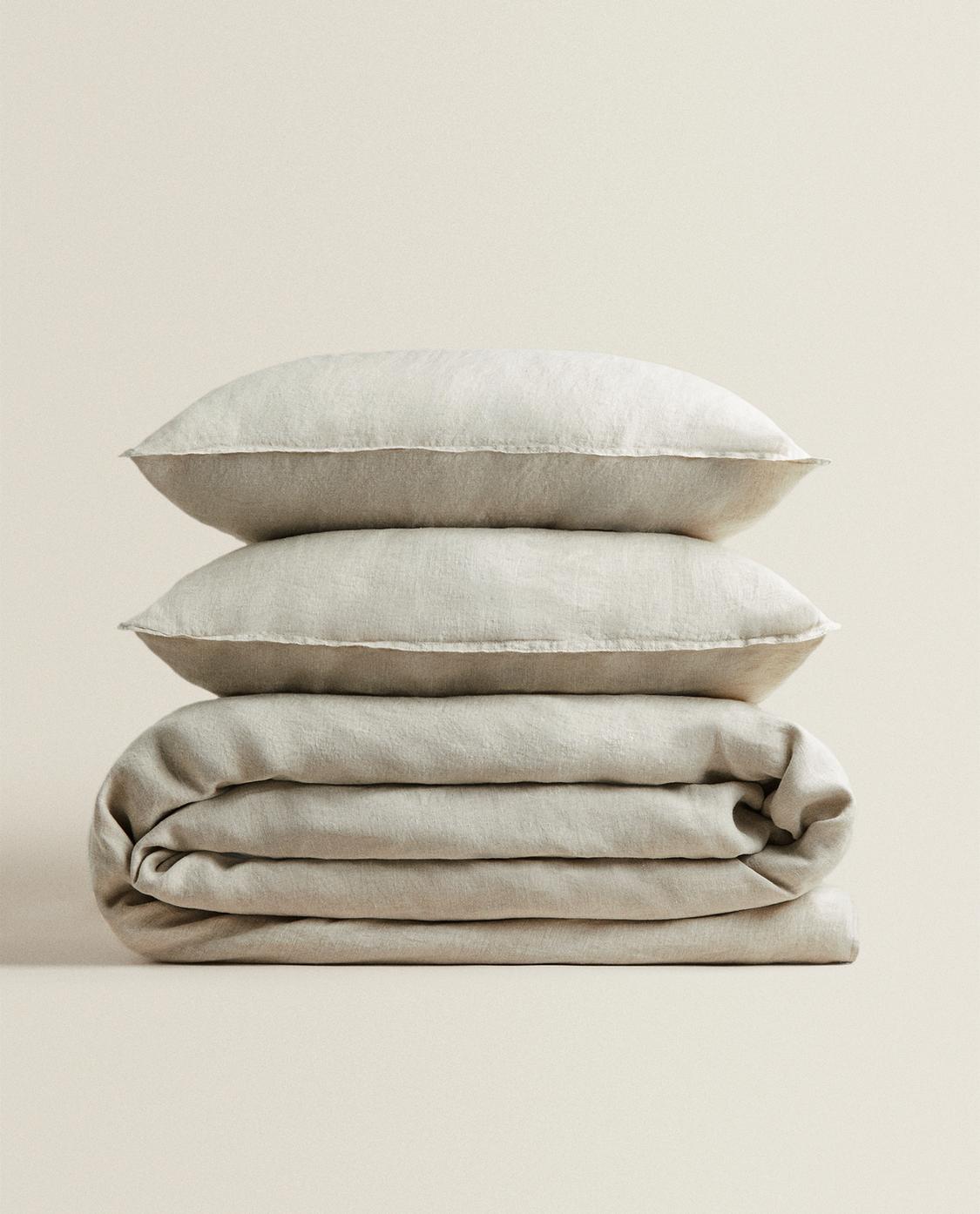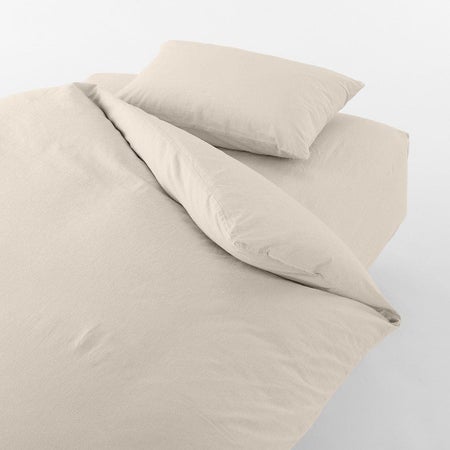Understanding Linen: The Eco-Friendly Option for Comfy Living
When you think of eco-friendly textiles, linen typically sticks out for its special qualities. This natural fabric, made from the flax plant, provides both convenience and sustainability. Its remarkable residential properties make it a suitable choice for cozy climate and resilient usage. What really establishes bed linen apart from other products? Comprehending its benefits and origins can transform just how you check out home fabrics. Allow's explore the interesting world of linen further.
The Origins of Bed Linen: From Flax to Fabric

Bed linen, one of the earliest textiles recognized to humankind, has a remarkable trip that begins with the modest flax plant. When harvested, the flax stalks undergo a process called retting, where they're soaked to divide the fibers from the woody parts.
When you see bed linen fabric, you're observing centuries of craftsmanship. Bed linen has been valued for its natural appearance and really feel, making it a favored for everything from apparel to home fabrics.
The Distinct Properties of Linen
One of the standout functions of this impressive textile is its breathability. When you put on bed linen, you'll notice how it allows air to circulate, maintaining you cool down on warm days. This residential property makes it an excellent option for summertime garments and sheets.
Linen likewise boasts exceptional moisture-wicking abilities, pulling sweat far from your skin and permitting it to evaporate rapidly. You will not really feel clammy, even in humid problems. In addition, linen is sturdy, typically becoming softer and more comfortable with each wash, which implies it can stand the test of time in your wardrobe.
Another special element is its all-natural appearance; the small abnormalities provide linen a personality that enhances your style. And also, it stands up to creases better than many various other materials, so you can delight in a relaxed yet polished look without much initiative. Welcome bed linen, and you'll value its convenience and unique charm.
Environmental Benefits of Bed Linen
When you pick linen, you're not simply selecting a lovely textile; you're likewise supporting sustainable manufacturing methods. Linen's naturally degradable and compostable nature makes it a smart selection for the setting. Plus, it requires substantially much less water to produce contrasted to other fabrics, aiding save this priceless resource.
Sustainable Manufacturing Practices
Although many fabrics have significant environmental impacts, bed linen stands out due to its sustainable production practices. When you pick bed linen, you're selecting a material made from the flax plant, which needs minimal water and pesticides. This resistant plant can prosper in bad soil problems, minimizing the requirement for chemical fertilizers. Additionally, the whole flax plant is utilized in production, minimizing waste and advertising resource efficiency.
Bed linen production is often much less energy-intensive compared to various other textiles, as it entails all-natural processes instead than artificial therapies. By sustaining bed linen, you're adding to a more sustainable fabric industry that focuses on environment-friendly methods. Picking linen not just enhances your convenience but likewise aligns your values with ecological obligation.
Compostable and naturally degradable Product
Bed linen's green nature expands past its lasting manufacturing; it's compostable and additionally eco-friendly, making it a superb selection for ecologically mindful consumers. When you choose linen items, you're deciding for products that break down naturally, returning nutrients to the planet. Composting bed linen can enhance soil, promoting healthy and balanced plant development.
Low Water Usage
One of the standout benefits of bed linen is its low water usage throughout growing. Unlike cotton, which calls for considerable watering, linen's flax plant prospers on minimal water, making it a much more lasting choice. You'll value knowing that for every heap of linen created, substantially less water is needed contrasted to many various other fabrics.
Linen vs. Other Fabrics: A Contrast
When you compare linen to various other textiles, you'll notice its remarkable breathability and convenience, making it best for cozy climate. Plus, bed linen stands out for its durability and durability, typically outliving several commonly utilized products. As you consider your selections, the ecological impact of each fabric will likewise play a crucial role in your decision.
Breathability and Comfort
Linen stands out among materials for its remarkable capacity to permit air flow. Unlike synthetic fabrics, which can trap warmth and dampness, bed linen's natural fibers wick away sweat, keeping you dry and cool.
Cotton is typically applauded for its softness, yet it does not match linen's breathability. Even blends could not use the same ventilation. If you focus on convenience, especially in summer, bed linen must be your go-to selection. It not just keeps you really feeling fresh however also brings a classic sophistication to your wardrobe.
Resilience and Long Life
While numerous materials provide varying degrees of sturdiness, linen truly excels in durability, making it a sensible investment for your wardrobe. Unlike cotton or synthetic materials that may wear out rapidly, linen gets stronger with each wash. You'll find that linen's breathable nature also reduces wear from sweat and moisture, which can damage various other textiles.
Environmental Influence Contrast
Although several textiles add to ecological problems, bed linen stands out for its green top qualities. Unlike cotton, which calls for substantial water sources and chemicals, bed linen is made from flax, a plant that flourishes on very little water and needs less chemicals. This suggests you can really feel great about your choice while reducing your carbon impact.
When contrasted to synthetic fabrics like polyester, linen's biodegradability shines. While polyester can take centuries to decay, linen breaks down naturally, returning nutrients to the dirt.
Selecting linen not just advertises sustainable farming practices yet likewise supports a much healthier world. By going with bed linen over traditional fabrics, you're making a conscious choice that benefits both your convenience and the atmosphere.
Caring for Your Bed Linen Textiles
To guarantee your bed linen fabrics remain in terrific condition, you'll intend to comply with some straightforward treatment guidelines. Clean your linen in cold water on a mild cycle to prevent it from reducing or shedding its form. Prevent using bleach, as it can harm the fibers. Instead, select a mild cleaning agent that's without harsh chemicals.
When it comes to drying, air drying out is best. If you utilize a clothes dryer, choose a low warm setup and remove the things while they're still slightly damp to lessen creases. Iron the bed linen while it's still damp for easier handling, or steam it to keep it looking crisp.
For storage space, maintain your bed linen in an awesome, dry location. Stay clear of straight sunlight to avoid fading. With these basic techniques, your bed linen fabrics will keep their appeal and last for many years, making them a sustainable addition to your way of life.
Integrating Linen Into Your Home Style
Looking after your bed linen fabrics not just preserves their quality but likewise opens a world of possibilities for integrating them into your home decoration. You can start little by adding linen throw cushions to your couch, immediately elevating the space with texture and heat. Take into consideration bed linen drapes that filter sunlight magnificently, producing a soft, airy atmosphere in any room.
For a more rustic appearance, try using bed linen tablecloths or joggers throughout meals; they include a sophisticated touch and are easy to tidy. If you're feeling adventurous, mix and suit different bed Linen Australia linen colors and patterns to produce a distinct, layered impact.
Don't ignore bed linen blankets-- curtain one over a chair or your bed for an inviting feeling. By thoughtfully incorporating linen into your décor, you improve both convenience and style, making your home a serene hideaway.
The Future of Linen in Lasting Living
As consumers progressively prioritize sustainability, linen becomes a frontrunner in green textiles. Its manufacturing uses much less water and pesticides compared to standard cotton, making it a more ecologically responsible option. As you look in the direction of a sustainable future, integrating bed linen into your wardrobe and home can substantially reduce your carbon impact.
Cutting-edge brands are now concentrating on sustainable methods, from making use of organic flax to executing round economic situation principles. You'll discover that bed linen's resilience suggests it lasts much longer, decreasing the requirement for regular substitutes.
Moreover, as more people accept minimal way of livings, bed linen's timeless appeal and flexibility will certainly maintain it pertinent. By picking bed linen, you're not just choosing comfort; you're likewise supporting sustainable methods.
In the upcoming years, the need for bed linen is anticipated to expand, solidifying its area in an extra eco-conscious world. Consider making linen a staple in your sustainable living journey.
Frequently Asked Concerns
Is Linen Appropriate for People With Allergies?
Yes, linen's natural fibers are hypoallergenic, making it suitable for people with allergies. Its breathable nature helps in reducing moisture and bacteria buildup, adding to a much healthier resting setting. You'll likely discover it comfy and risk-free.
Can Linen Be Dyed Conveniently?
Yes, you can color bed linen quickly. Its natural fibers absorb dyes well, allowing for vibrant shades. Simply ensure you utilize the best dye kind and comply with appropriate techniques to achieve the wanted outcomes without harming the textile.
Exactly How Does Linen Compare in Resilience to Cotton?

What Weight of Bed Linen Is Best for Summer Apparel?
For summer clothing, light-weight bed linen around 4 to 5 ounces per backyard is excellent. It maintains you great, breathable, and comfy in warm weather condition (Linen). You'll appreciate how it drapes and moves with you easily

Can Linen Be Made Use Of for Outdoor Furnishings?
Yes, you can make use of linen for outdoor furniture. It's resilient and breathable, making it a wonderful selection for cozy weather. Just be sure to select a treated variation to withstand the elements and maintain its look.
Verdict
Including bed linen right into your life not just improves your comfort but also supports a more lasting future. By picking this green textile, you're making an aware choice that benefits both your well-being and the planet. With its unique residential or commercial properties and minimal ecological influence, linen is a smart choice for your home style and way of living. Accept linen, and enjoy the excellent mix of style, resilience, and sustainability in your day-to-day living.
Bed linen's naturally degradable and compostable nature makes it a wise choice for the setting. By incorporating bed linen into your home, you're not simply enjoying its convenience and sturdiness; you're also sustaining eco-friendly techniques and helping produce a much healthier planet. The Future of Bed Linen in Sustainable Living.
